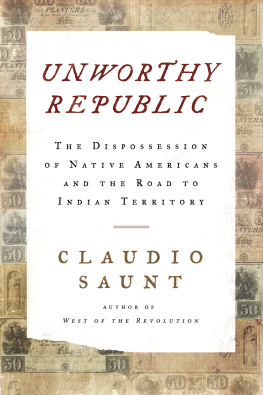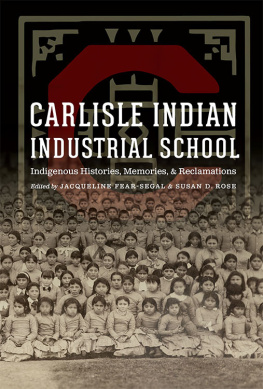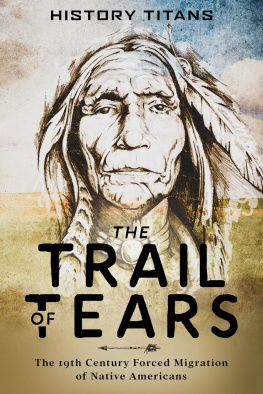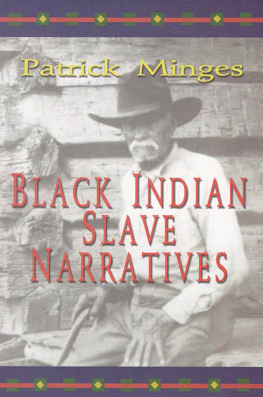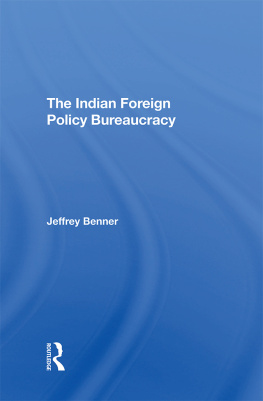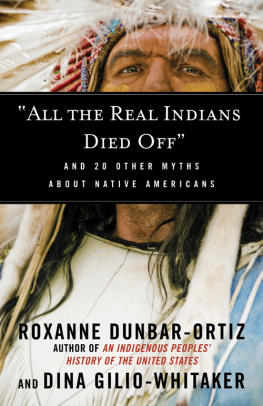
UNWORTHY
REPUBLIC
THE
Dispossession OF
Native Americans
AND THE
Road TO
Indian Territory
~~~
CLAUDIO SAUNT

W. W. NORTON & COMPANY
Independent Publishers Since 1923
We have our misfourtine as with other nations on this continent. The Cherokees have bin treated by the American Republic unworthy of the head of a civilized goverment her name will go down to future eyes with scorn and reproach on her head. She will fell it in her legislative halls it never will be eradicated from her history historians will have to write it down on her pages which will go down to the latest posterty.
J AMES A. F OLSOM , a young Choctaw student at Miami University of Ohio, to his uncle, Peter Pitchlynn, October 31, 1831
~~~
The same week of the Fourth, state militia waded through mud and water and descended on a camp of dispossessed indigenous Americans in southwest Georgia, killing twenty to thirty of the refugees. The fleeing survivors left trails of blood in their wake. U.S. troops force-marched 1,600 native men, women, and children toward steamboats docked at Montgomery, Alabama. The men walked in iron chains. In southern Alabama, soldiers pursued a group of native people into a swamp, where they shot and killed four of them. In Tennessee and North Carolina that summer, U.S. citizens drove indigenous families off their farms with cowhide whips and hickory clubs. The dispossessed took refuge in the dense forests of the Appalachians, where they fought off starvation. In Florida, some four thousand U.S. troops spent the Republics sixtieth birthday waging war against the regions longtime residents. They had recently shipped 450 native people westward across the Gulf of Mexico and up the Mississippi River. Only three hundred of the destitute deportees survived to reach their destination, a place called Indian Territory.
The summer of 1836 belongs to the decade of Indian Removal, as the policy was and is still known. Indian Removal is the subject of this book, though I do not use either word except in historical context. Indian is for good reason a designation of pride for many native people in the United States today, but when used to describe the diverse individuals and communities who were expelled from their homelands in the nineteenth century, its fanciful and specious associations distort our understanding of the past. Indians were savage and primitive or noble and in touch with nature. They were stoic, brave, cowardly, untrustworthy, honorable, and doomed. The men were not husbands and fathers but warriors, the women squaws, maidens, or burden bearers. Political leaders were chiefs, and communities or nations were tribes. Indians were, in short, different from other people. The label conjures up so many stereotypes that it clouds the mind, making it impossible to see the past clearly. In the context of American history, it evokes tragedy and inevitability, creating a dense fog that obscures the choices that U.S. politicians and their constituents made in the early years of the Republic.
Removal is equally unfitting for a story about the state-sponsored expulsion of eighty thousand people. It is a soft word, said the Massac husetts representative Edward Everett in a debate on the floor of the House in 1830, and words are delusive. Then and now, it conveys no sense of coercion or violence. The phrase Indian Removal, coined by proponents of the policy, has all of the problems of its two constituent terms and possesses an additional fault. In the nineteenth century, people removed themselves to new locales or were removed for committing crimes. Indian Removal, however, was an unusual construction that left unstated who was removing whom. Were Indians doing it to themselves? The phrase is artfully vague.
There are other ways of describing what the United States did to indigenous people in the 1830s. Human rights activists, writing about events in the twenty-first century, speak of forced migration, but I am not alone in finding the phrase too distant from events on the ground. Ethnic cleansing, a term of propaganda that became widely used during the Bosnian War in the 1990s, is rightly criticized for being nebulous and even for obscuring violence. Genocide elevates a single question above all others: Does the event fit the definition of the crime, as defined by the 1948 United Nations Convention on Genocide? European colonists and their descendants undeniably acted with genocidal intent at certain times and places, but how often and how extensively is a matter of debate. My focus lies elsewhere.
I use three other words to describe U.S. policy in the 1830s. One is deportation. Deportation is conducted by states, and the term therefore captures the administrative and bureaucratic process that underpinned the federal governments expulsion of native peoples. Since a nation can only deport people who are on its soilbeyond its borders, it must resort to diplomacy or force of armsdeportation also points to the U.S.
I was inspired to tackle this project when I inherited a cache of letters from my grandfather, who escaped from Hungary to Cleveland, Ohio, in December 1937. He corresponded with his parents and siblings in Storaljajhely, in northeastern Hungary, until 1944, when Nazis deported them to Auschwitz. Reading through the letters, I began to reconsider the deportation that occurred a little over a century earlier near my current home in Athens, Georgia. Some of the towns main streetsLumpkin, Clayton, Dearingbear the names of local figures who played national roles in this earlier deportation. There are several striking similarities between the expulsion of indigenous peoples in the 1830s and the state-sponsored mass deportations of the twentieth century in Turkey, Greece, Germany, the Soviet Union, and elsewhere. In both periods, administrators described the inevitable march of civilization, the necessity of deporting populations that could only with difficulty assimilate, and the grandiose plans that they had devised to address the situationarrogant language that masked the brutality and disarray of their efforts.
The Indian question was the U.S. counterpart to Europes Jewish question, two formulations that invited paternalistic measures at best, expulsion or extermination at worst. Indians, like Jews, Gypsies, slaves, and free negroes, wrote the Georgia Journal in 1825, were a kind of citizens of an inferior order. What was to be done with them? By the 1830s, the expression the Indian question was circulating widely in the United States. About a decade later, the Jewish question began appearing The United States, the self-described exceptional nation, was not so exceptional in this instance; it belongs on a woefully long list of states that sponsored mass deportations. In fact, it was among the first in the modern era to undertake such an operation.
Rather than systematically comparing and contrasting modern deportations, however, I am more interested in exploring the deportation that sits at the heart of the American Republics first century. This book makes three related arguments. First, it argues that the state-administered mass expulsion of indigenous people was unprecedented. At first glance, this assertion may seem foolish. From the moment the British set foot in North America, they began driving off native residents. By 1830, the continents original inhabitants retained only one hundred thousand of the approximately million square miles in the United States east of the Mississippi River. Nonetheless, in the long history of dispossession in North Americaof the Pequots, Narragansetts, Wampanoags, Yamasees, Tuscaroras, Guale, Natchez, and so onthe U.S. policy of mass expulsion in the 1830s was a first. In previous decades, British, Spanish, and French colonists had driven out indigenous people by waging war, introducing fatal viruses, destroying the environment, and proselytizing, while this time the United States subjected Native Americans to a formal state-administered process that produced censuses, property lists, land plats, expulsion registries, commutation certificates, and the like, all culminating in a journey, by foot, wagon, or steamboat, to lands west of the Mississippi.
Next page
